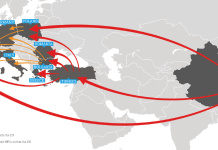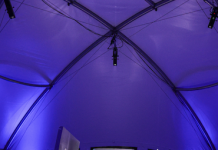We are all very familiar with the concept of Free Cooling: in the old days, the solution to cool down our car, made hot by the sun, was to open the windows, as the outside was colder than the inside. The same applies to HVAC: whenever the outside temperature is low enough to cool down the space or the process fluid without the intervention of a chiller (mechanical cooling), we can implement a Free Cooling solution. Depending on the system, it can be a dry cooler for a chilled water loop or the economizer of a rooftop or air-handling unit. The advantage is clear: the electrical consumption for the compressor is minimized or eliminated and we are getting our cooling almost for free (fans and pumps are still needed). Free cooling is definitely the cheapest and greenest way to provide cooling.
Something less obvious, but effective, can happen also for the heating load. For analogy, we can call it “Free Heating” and this time the device to add in the system is a heat pump. A heat pump is a thermodynamic machine which elevates the grade (a.k.a. temperature) of the heat, pumping it from a cold source to a heat sink. The cold source is generally a renewable source, such as the ambient air, the ground, a lake, exhaust gases or fluids. When applying a heat pump, we are subtracting 300kW from those renewable sources, spending 100kW of electricity to run the thermodynamic cycle, producing something like 400kW of useful heat (COP = 4, depending on the machine, the temperatures, etc…). In comparison, a boiler would use 400kW (or more) of fossil fuel to generate the same 400kW of heat. By using a heat pump we are producing roughly 75% of the heat from renewable sources.
The remaining 25% is the next target to eliminate, before we can speak about “Free Heating” and define it as the “cheapest and greenest way to provide heating”, as we said for Free Cooling.
There are at least two great examples to do that.
- Heat generation with cooling recovery. Take the example of a hospital in summer. Traditionally, they are running a 3MW cooling system, but still need 400kW for hot water needs, using a gas boiler. So the baseline is: 3MW of cooling, 400kW of heating, for a consumption of 1MW of electricity (for the chillers) and 400kW of gas. Consider to replace the boiler by a W/W heat pump, with the cold source being the hospital cooling loop. The heat pump will generate 400kW of heat, consuming 100kW of electricity and providing, at the same time, 300kW of cooling. That means that the chillers will need to produce only 2.7MW of cooling now to satisfy the original 3MW demand. The new scenario is the following: 3MW of cooling (2.7MW from chillers, 300kW from the heat pump), 400kW of heat, with a consumption of 1MW of electricity (900kW for the chillers, 100kW for the heat pump). Full stop. The hospital has 400kW of heat 100% free, as the gas consumption of 400kW disappeared.
- Heat generation with renewable electrical energy. Let’s consider the common case of a small assembly factory in Italy, with a PV plant installed on the warehouse roof. They made the investment to reduce their electricity bills in summer, when they need to run their chillers for air conditioning. In winter, though, they are still running boilers for heating, while the PV plant is overproducing and exporting to the grid, with little economic advantage – as the maximum gain is when electricity is used for self-consumption. When replacing the boiler with an A/W heat pump, they can now run the heat pump with 100% free renewable energy, leveraging their PV investment also during the winter season and accelerating the payback time.
Those are just two simplified cases where heat pumps can be effectively used to generate “Free Heating”. In real cases, a deeper analysis is required to create the baseline, starting from a good understanding of the heating demand and load profiles.
When looking at the barriers for heat pumps and “Free Heating” implementation, the two main ones are solvable today.
Hot water temperature: the most recent products, based on HFO refrigerants such as R1234ze, are capable of maximum temperatures similar to boilers, as high as 85°C. Most of applications are covered, including any form of Space Heating or Domestic Hot Water, including Legionella prevention.
First cost: a heat pump is definitely more expensive than a boiler, but with lower operational costs. If the typical investment with a payback time is not attractive enough or if there is a problem of cash, there are long or short term rental solutions, where the heat pump is supplied in the form of an “Equipment-as-a-Service”, with a monthly fee. The additional advantage of this type of contracts is the full coverage of the machine, from a maintenance and warranty point of view, with a minimization of the risk for the end user.
In conclusion, “Free Heating” by using heat pumps has become a concrete solution to accelerate the decarbonisation of heating and reduce our CO2 footprint thanks to:
- The significant amount (50% or more) of renewable energy directly repurposed as useful heat;
- The possibility of using not only the heat but also the cooling effect;
- The possibility to use renewable electricity;
- The high water temperature achieved by using new zero GWP refrigerants such as R1234ze;
- The “Equipment-as-a-Service” business model.
Author: Guido De Sanctis, Services Business Leader HVAC Europe, Trane




